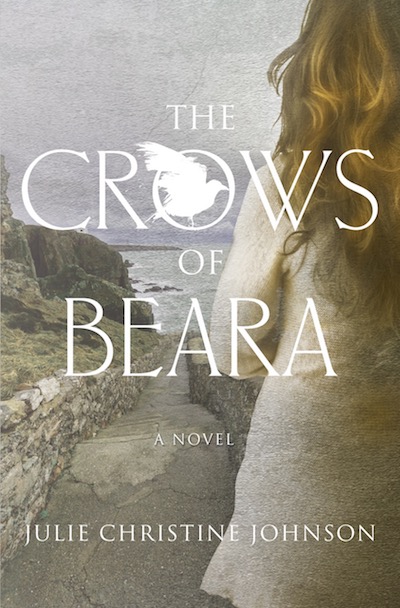The Crows of Beara: A Novel
- By Julie Christine Johnson
- Ashland Creek Press
- 300 pp.
- Reviewed by Sally Shivnan
- September 10, 2017
A story about an outsider’s view of contemporary Ireland and the trade-offs a rural community faces.

The Crows of Beara is a love song to Ireland that combines dazzling views of wild, sweeping landscapes with a hard, honest look at the need for jobs in the country’s rural west. This contrast drives events in the novel as the community at the center of the story struggles to decide whether the environmental risks of a proposed copper mine outweigh the promise of economic development.
Enter Annie, an American public-relations specialist sent by the mining company to win over the locals, and Daniel, an Irish artist passionate about the land but wary of getting dragged into the limelight. Both are dealing with their own turmoil, haunted by tragic mistakes from the past. Romantic, but unrequited, sparks soon fly between these two, and the plot thickens with intrigue, feuding, loyalty, and love.
Johnson’s novel may appeal to readers who prefer an accessible writing style and straightforward story, particularly if they are interested in Ireland’s culture and natural beauty. The book includes many lyrical passages describing the land, although the best of this writing is simple and spare: “Kenmare Bay winked in the distance; clouds drew shadows across the brown skin of the eastern hills.”
Johnson does not shy away, however, from a stark portrait of Ireland’s challenges after the end of the “Celtic Tiger” economic boom 10 years ago. She describes “an Ireland stupefied by failure, depressed, her eyes glazed over with shock. The high times had vaporized.”
Johnson’s writing is assured and passionate when she talks about the country’s post-boom situation:
“Behind the tidy gardens set against houses painted in rainbow-bright colors, beyond the postcard fields of wildflowers and woolly sheep were families trying to hold together lives that had gone from economic boom to bust in a decade. In those very fields lay the ruins of famine houses — homes abandoned during the Great Famine of the mid-1800s — left to crumble as a testament to the sorrows of the past.”
This picture of the Emerald Isle is an outsider’s view — the view of the book’s American protagonist, Annie, and of Julie Christine Johnson, its author. The ideas are reminiscent of ideas presented by Irish writers, but flavored by Johnson’s outsider stance.
The fact that both the threats and the opportunities in The Crows of Beara come from beyond Ireland’s borders complicates this outsider view. As Daniel wonders, “Who were any of them to determine what the region needed and who could best meet those needs?”
The economic issues that Johnson explores are ones that have parallels in the U.S. and around the world, which makes her commentary even more compelling. For example, the low-paying service jobs that accompany the new economic reality “might pay a pittance, but that pittance could keep a family off public assistance or pay a son’s tuition at a technical college or home care for an elderly parent.” These are trade-offs that many societies, and individuals, face.
The portrait of corporate culture in the book is also interesting — in particular, the way it depicts international corporations’ treatment of women. Annie fights for her place in that culture and proves herself brave and tough, although this only causes the men surrounding her to treat her more ruthlessly.
They are undoubtedly threatened by her competence, but this makes it no less painful when they humiliate her, as in one chilling scene in which a colleague condescendingly, and very publicly, slows down his speech to her to make her feel like a child.
Much of the novel’s plot, unfortunately, is predictable — the ending comes as no surprise — and the steps along the way often falter. The attempt to incorporate myth and magic, with the characters hearing mystical voices on the wind, is clumsy. Annie’s alcoholic relapse is unconvincing, lacking the attention and development it deserves.
The writing depends too much on exposition and, in places, this exposition waxes sentimental, as when Daniel discovers he “was drawn to her, drawn in by the vulnerability and pain that he knew so well, had worked so hard to slough off his own soul, like a snake shedding tired, used skin.”
At the end of the novel, the scene in which the two protagonists finally get together happens off stage, depriving readers of the chance to experience what the book has been building toward since its start. Missing, too, at the end, is any focus on the continuing issue of the lack of jobs in Beara, even though the problem of unemployment has been a theme throughout the story.
The Crows of Beara is a love song that goes up and down in pitch. It sings to landscapes, mythology, culture, and politics in a land far away for American readers. It misses some notes, but the melody is clear. Readers interested in a song of contemporary Ireland may find themselves humming along.
Sally Shivnan is the author of the short-story collection Piranhas & Quicksand & Love. Her fiction and essays have appeared in the Georgia Review, Antioch Review, Glimmer Train, and other journals, and her travel writing has been featured in anthologies including Best American Travel Writing, as well as in the Washington Post, Miami Herald, Nature Conservancy Magazine, and many other publications and websites. She teaches at University of Maryland Baltimore County (UMBC).

_80_120.png)